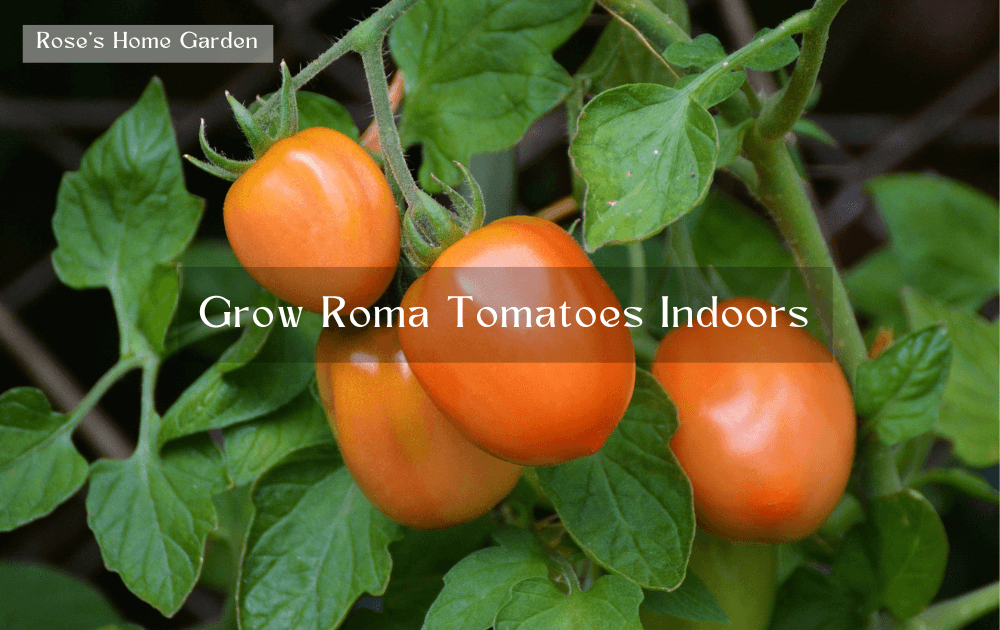
Grow Roma Tomatoes Indoors | Follow These 8 Steps
The joy of growing something indoors is not just about the fruit, it’s about the entire journey we come through. From selecting the perfect pot to the first bite, every step of the way is filled with emotions of excitement, expectation, and pure delight. Today is all about growing your own juicy, flavorful Roma tomatoes right in the comfort of your own home! Is it really possible to grow Roma tomatoes indoors?
Well, fear not my fellow tomato lovers, because, with a little bit of effort and some love, you can easily grow them in a corner of your balcony, terrace, or just on the windowsill. Roma tomatoes are an excellent choice for indoor growing as they don’t require a lot of space and can thrive in small pots and in low light. So, get ready to embark on this adventure, roll up your sleeves, put on the gardening gloves, and let’s grow some juicy Roma tomatoes indoors!
Can You Grow Roma Tomatoes Indoors?
Yes, you can absolutely grow Roma tomatoes indoors! In fact, it is an excellent option for those who don’t have access to outdoor space or live in areas with short growing seasons. It is important to provide Roma tomatoes with adequate light, nutrients, and care in order to grow them indoors.
Keeping indoor tomato growing conditions as similar as possible to outdoor conditions is key to success. This means you need to provide your Roma tomato plants with at least 6 to 8 hours of bright, indirect sunlight per day. Use quality potting soil and ensure provide sufficient water and nutrients to the plants.
Grow Roma Tomatoes Indoors | Step-by-Step Guide
The experience of growing Roma tomatoes indoors can be exciting and rewarding and can provide a sense of accomplishment and pride. When seedlings sprout, grow, and blossom into full-fledged plants bearing fruit that you can share with family and friends, there’s something truly magical about it. Follow these steps to successfully harvest and enjoy juicy tomatoes.

Step 1: Choose the Best Container to Grow Roma Tomatoes
Generally, Roma tomatoes require a container that is at least 12 to 18 inches deep and 18 to 25 inches wide. It provides enough space for the plant’s roots to grow and spread. The container’s depth is particularly crucial, as Roma tomato plants have long taproots that need adequate space to develop.
A container that is too shallow may lead to stunted growth and poor yields. Overall, while choosing a container to grow Roma tomatoes, make sure you think of providing enough space for the plant’s roots to grow and ensure drainage.
Step 2: Germinate Roma Tomato Seeds
Start with seeds that are fresh, plump, and free of cracks or blemishes. Place them in warm water and let them soak for about 12 to 24 hours to soften the seed coat and promote germination. Fill the container with a moistened, sterile seed starting mix. Use a pencil to create small holes about ¼ inch deep place 1 to 2 seeds in each hole and cover them with soil.
You can cover the container with a plastic wrap or dome to retain moisture and warmth as you have to keep it in a warm, bright location, but out of direct sunlight. Germination of your Roma tomato seeds should occur within 8 to 10 days. Once the seeds have sprouted, remove the plastic cover or dome to allow air circulation.
Step 3: Transplant Your Roma Tomato Plant
Once your Roma tomato seedlings have two or more leaves, it’s time to transplant them into the final container that we talked about in the first step. You don’t need to transplant it if you had already germinated the seeds in that container. Make sure the container has good drainage and is filled with a high-quality potting mix.
Step 4: Provide Light to Grow Roma Tomatoes Indoors
Once your Roma tomato seedlings have emerged, move them to a bright location that receives at least 6 to 8 hours of direct or indirect sunlight per day. If you don’t have access to enough natural light, you can also consider using grow lights too. The plant will need both morning and afternoon sunlight. The morning sun helps in photosynthesis and the afternoon sun for the healthy development of the plant.
Step 5: Water Your Roma Tomato Plants Regularly
Regular watering is very important for Roma tomatoes. So keep the soil moist but not waterlogged. Water at the base of the plant, avoiding the leaves to prevent fungal diseases. Water the plants with at least 1 to 2 inches per week.
Step 6: Fertilize the Tomato Plants Regularly
Feeding your Roma tomato plants with a balanced fertilizer every 2 to 3 weeks is a great idea to have a better harvest. You can simply use organic compost, worm castings, or even make your own compost (click here to learn) to provide nutrients to the plants. Cottonseed meal is also a great fertilizer for Roma tomatoes as it is filled with nitrogen, potassium, and phosphorus.
Step 7: Provide Support and Prune as Needed
When the plants get larger, they might become top-heavy, requiring support. Keep the plants upright with stakes or cages to avoid them falling over. It is a good idea to pinch off the lower leaves and suckers (the growth between a leaf and the stem) in order to encourage bushier growth and higher yields. It will allow the plant to focus its energy on producing fruit rather than foliage.
Step 8: Watch for Roma Tomato Pests and Diseases
Roma tomato plants are highly vulnerable to various pests and diseases. So make sure you are ready to fight against them. Some common pests and diseases to watch for when growing Roma tomatoes are aphids, whiteflies, spider mites, blossom end rot, tomato hornworm, and fusarium wilt.
Early blight is the most common fungal disease that causes brown spots on the leaves, which can spread to the fruit. To prevent early blight, water the plant at the base, not on the leaves, and remove any infected leaves.
Can Roma Tomatoes Grow in the Shade?
Yes, but in some cases. Roma tomato plants need plenty of sunlight (6 to 8 hours) to thrive, but they can still tolerate some shade. However, the plant may not produce as much fruit or grow as vigorously as it would in full sun. Keep in mind that too much shade can increase the risk of disease and pest problems, so it’s important to provide as much sunlight as possible.
Do Roma Tomatoes Grow in Florida?
Yes, Roma tomatoes grow well in Florida as it is a major producer of tomatoes in the United States and is known for its ideal climate for tomato cultivation. Among commercial and backyard growers in Florida, Roma tomatoes are popular because they produce fruit in a concentrated period, making them excellent for processing and canning.
Do Roma Tomatoes Grow in Arizona?
Yes, Roma tomatoes can be grown in Arizona as it has a warm and dry climate. Roma tomato is a popular variety for commercial and backyard growers in Arizona, as they are a determinate variety. Yet, since Arizona has a hot and arid climate, it is important to provide Roma tomato plants with adequate irrigation and protection from the intense sun.
Grow Roma Tomatoes Indoors Successfully
In conclusion, growing Roma tomatoes indoors and enjoying the first juicy harvest can be a fun and rewarding experience for any gardener. By following the 8 steps outlined in this guide, you can create an appropriate environment for your Roma tomato plants to thrive and produce delicious fruits. With a little patience and care, you can enjoy the taste of freshly grown Roma tomatoes right in the comfort of your own home. So go ahead, give it a try, and like always, happy gardening!
Tag: Grow Roma Tomatoes Indoors | Follow These 8 Steps


